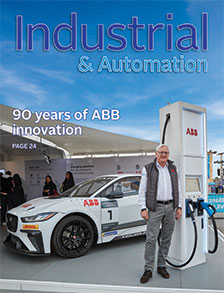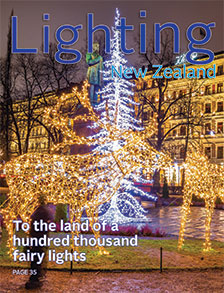Issue 154 March - April 2023Please note: The issue content below is just a summary of the articles in the printed magazine.
The articles are not available on-line.
Please refer to the printed magazine for the complete article.

COVER STORY
IP Enclosures for tough protection
Named after what it sells, IP Enclosures NZ Ltd, is now supplying a range of ingress-protected electrical enclosures, cabinets and data racks to the manufacturing, utility and electrical contractor market.
Director Joe Allison says there are over 500 enclosure options in the company’s catalogue designed to meet any need.
IP Enclosures NZ has been operating for about a year in New Zealand, while its parent operation has been supplying enclosures to the Australian market since 2007.
Managing director, Anthony Hungerford, says the company has supplied thousands of electrical and data enclosures across both countries and has exported throughout Europe, UK, USA, Dubai UAE and Asia Pacific regions.
“All our enclosures are designed to European and international standards to suit the New Zealand market as well as the countries that our local OEMs are exporting their equipment to.”
Hungerford says not only are all their cabinets designed to relevant standards, they are also manufactured in Europe to those standards to ensure every customer receives the quality they expect.
Please refer to the printed magazine for the complete article
NEWS
Proposed new code expands EWRB discipline
Allegations of fraud, false advertising, property damage, threats of violence, and abusive and poor behaviour against electrical contractors are being cited by MBIE to validate the expansion of the EWRB disciplinary regime to cover crimes of misconduct.
According to a consultation document released by MBIE in February, the government intends to amend the Electricity Act this year to give the EWRB sweeping new powers to “manage poor conduct” and improve the public’s trust and confidence in the ‘profession’.
Currently the EWRB’s disciplinary powers are limited to the conduct of prescribed electrical work. The government wants to expand this to include any form of conduct that MBIE might want to include in a code of ethics. Complying with the code will become a condition of gaining and retaining a worker licence.
Codes of ethics are typically used in professions, unlike the electrical trade which is regulated extensively by prescriptive law and cited standards which control how work has to be delivered. MBIE wants to bring in speech and behaviour controls that will sit above regulation and allow its gender-balanced Board to control how electricians address customers and conduct commercial aspects of their business with them.
The worst behaviours identified by MBIE in Figure 1 are already illegal under different acts of parliament and are not required to be duplicated in electrical legislation. However, the government wants to broaden the power and disciplinary scope of the EWRB to more like a court in these matters. In doing so it will shift the cost of enforcement onto all electrical licence holders, while enabling the public to use the threat of complaint against an electrical contractor to renegotiate the price of a job after it is done.
Please refer to the printed magazine for the complete article
NEWS
New standard for electrical safety in old buildings
Electrical safety upgrades in old buildings can now be carried out with greater certainty following the release of an updated standard for verifying the safety of existing electrical installations.
Seven years in the making, the new edition of AS/NZS 3019 includes a new Section 6 designed for New Zealand electricians to measurably enhance the electrical safety of aging homes and buildings without having to rewire them to AS/NZS 3000.
Where these installations were compliant at the time they were built, no matter how long ago, they remain compliant today, but the safety level of the installation is likely to have degraded over time. Old installations also lack the safety devices of today such as RCDs, MCBs and AFDDs so the level of safety is significantly below a new installation designed to the latest, if yet uncited, version of the Wiring Rules.
Please refer to the printed magazine for the complete article
Inspector concerns need to be heard
Electrical inspectors are at the tip of the spear when the safety and compliance of high-risk work has to be verified. For his masters degree thesis, electrical inspector Tony Doyle interviewed inspectors to identify stress points in the industry that need addressing to improve safety. He comments on three of those areas as follows.
In a bid to understand the perspectives of electrical inspectors within the industry, I have carried out a rigorous academic research study, shedding light on their perceptions in relation to the state of compliance in New Zealand. This study, carried out under strict academic conditions for a Masters Degree, covered a wide range of topics and uncovered valuable insights into the current state of the industry in New Zealand.
The research showed that electrical inspectors are particularly concerned about the EWRB's biennial competence course requirements (formally known as the electrical refresher training course). The electrical inspectors voiced their disappointment with the frequency and quality of electrical refresher training in New Zealand. They made comments such as:
Please refer to the printed magazine for the complete article

COVER STORY
90 years of ABB innovation
In 1924 when the Union Steamship Company built its revolutionary ocean liner and refrigerated cargo ship, Aorangi, it was the fastest and largest motor-driven vessel in the world.
The Aorangi arrived in Auckland on its maiden voyage powered by Brown-Boveri turbo-blowers and marked the first Brown-Boveri presence in New Zealand of what was to become the global engineering giant, ABB.
The other ABB partner, ASEA, had already been supplying products into New Zealand since the first delivery of a transformer in 1898. The first 3-phase motor connected to the New Zealand Government’s hydro-electric supply was an ASEA motor and the first synchronous induction motor ever used in New Zealand was an ASEA machine.
From the early days of electrification, ASEA and Brown-Boveri played a pioneering role in the industrial development of New Zealand and now, as ABB Ltd, the company continues to introduce new electrical technologies developed in its manufacturing facilities overseas as well as locally.
ABB’s country holding officer, Ken
Mulcock, says it is now 90 years since ABB formally began in New Zealand as ASEA Electric NZ Limited.
“ABB has achieved many milestones since then and our commitment to the ongoing development of the industry and our role in it is as strong as ever.”
Please refer to the printed magazine for the complete article
The important role software engineering plays in industry
The last decade or so has seen a sharp increase in the demands placed on industrial control systems. This is due in part to the increased levels of automation needed to make products efficiently. Applications are also having to fulfil ever greater and more diverse customer requests.
These ever-increasing demands have led to what seems an exponential rise in the complexity of programs used within industrial control systems – a trend that seems certain to continue well into the future. The overall value of a control system has moved away from its hardware, and is now heavily weighted towards its software, which contains the intellectual property (IP) of the overall system.
Software development therefore needs to be carefully controlled to prevent programs becoming unwieldly, difficult to maintain and highly time consuming to fault find. If not kept in check, program management will become ever more expensive and burdensome for industry.
Fortunately, attention is increasingly being paid to the software engineering practices used in industry. This will become ever more important as companies digitise their operations, and will avoid costly blow outs for software projects.
Please refer to the printed magazine for the complete article

COVER STORY
To the land of a hundred thousand fairy lights
This Christmas, my wife and I travelled back to Finland for our first white Christmas after the covid curfew. Although I had previously lived and worked in Finland, this was to be my first time back with the critical eye of an experienced lighting designer. I was intrigued to see whether my memories of the lighting industry were the same as today, and if the uptake of LED technology had improved some of the areas I remembered as being a bit lacklustre.
First things first, the one major light source I remembered lacking during winters, was still evident. In four weeks, unless you call a warm glow on the horizon evidence of the sun, then this was pretty much still missing from Finnish winters. Although in Helsinki, which is in Southern Finland, the sun technically was rising about 9:30 am and setting about 3:30 pm, this felt like a theoretical happenstance only.
Any of you who have lived or visited a territory in the more northern climes, like Canada, Scandinavia or even the northern UK, will be able to recall the shortness of the days and the often-daily feud with the snows that are entailed. This leads to some interesting peculiarities of life in the endless night cycle.
Scandinavians are renowned for being early adopters of light as therapy, to battle the depression that can be brought on by lack of sunlight (SAD, or seasonal affective disorder). In the north of Finland, around Lapland, the sun sets in late November and does not rise again until mid-January. Some people have high intensity lights that they use for a short period to mimic the effect of sunlight, others, in fact to be honest most, just deal with it the best they can.
Please refer to the printed magazine for the complete article
How new technologies are changing lighting
As we leave 2022 in the rear-view mirror, it is a good time to look forward to future possibilities in the field of lighting and keep an eye on emerging technologies and legislative change. This subject was brought into focus by two recent changes for 2023, one being the obsolescence in Europe of CFL and fluorescent lamp technologies, the other being the introduction of new artificial intelligence (AI) technologies like that of ChatGPT.
The first brings to the fore the impacts of physical change within our industry, as combined technology and legislative advances drive us away from less energy efficient products and those with a poor environmental footprint.
The second is just as monumental but has a broader impact across all aspects of our lives. It is the rise of artificial intelligence in new applications across all industries.
Traditional lighting sources like incandescent bulbs and fluorescent lamps are becoming outdated, inefficient and also legislated out of use. There is a growing need for new lighting solutions that are more environmentally friendly and sustainable. Looking forward to progressive adoption of modern technologies, there are several exciting prospects on the horizon.
Please refer to the printed magazine for the complete article
|